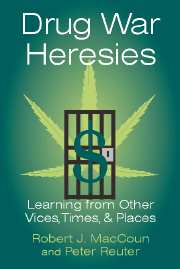Book contents
- Frontmatter
- Contents
- List of Figures and Tables
- Acknowledgments
- PART I OVERVIEW
- PART II THE ARGUMENTS
- PART III THE EVIDENCE
- 7 Other Vices: Prostitution and Gambling
- 8 Other Substances: Alcohol and Cigarettes
- 9 U.S. Experience with Legal Cocaine and Heroin
- 10 Learning from European Experiences
- 11 Cannabis Policies in The Netherlands
- 12 Harm Reduction in Europe
- PART IV ASSESSING THE ALTERNATIVES
- Bibliography
- Data Sources for Figures
- Author Index
- Subject Index
7 - Other Vices: Prostitution and Gambling
Published online by Cambridge University Press: 24 May 2010
- Frontmatter
- Contents
- List of Figures and Tables
- Acknowledgments
- PART I OVERVIEW
- PART II THE ARGUMENTS
- PART III THE EVIDENCE
- 7 Other Vices: Prostitution and Gambling
- 8 Other Substances: Alcohol and Cigarettes
- 9 U.S. Experience with Legal Cocaine and Heroin
- 10 Learning from European Experiences
- 11 Cannabis Policies in The Netherlands
- 12 Harm Reduction in Europe
- PART IV ASSESSING THE ALTERNATIVES
- Bibliography
- Data Sources for Figures
- Author Index
- Subject Index
Summary
The legalization debate gives almost no attention to two vices, prostitution and gambling. Yet both share important attributes with illegal drugs; they bring pleasure to large numbers, pose a moral issue for many people despite attracting a substantial share of the total population (males only in the case of prostitution), and create massive illegal markets when they are prohibited. Gambling, but not prostitution, becomes habit forming and causes harm to a modest or large fraction in the long-run. Legal control of these vices, in particular whether they should be prohibited, has been a matter of debate for over a century.
Both vices raise issues for regulation and prohibition similar to those encountered in the drug legalization debate. For example, how great are the harms of the activity or substance itself? How does one weigh the moral consequences of widespread flouting of the law against the increased prominence of the disapproved behavior accompanying legalization? Is there a mode of regulation that approximately achieves the control level of prohibition without creating the illegal market? They also raise common political issues: how are choices about prohibition and regulation framed politically?
Something can also be learned from the differences in the fates of the regimes for these two activities. Illegal gambling and prostitution were both central problems for city governments until the 1960s because they were so closely connected with organized crime and urban corruption.
- Type
- Chapter
- Information
- Drug War HeresiesLearning from Other Vices, Times, and Places, pp. 128 - 155Publisher: Cambridge University PressPrint publication year: 2001

